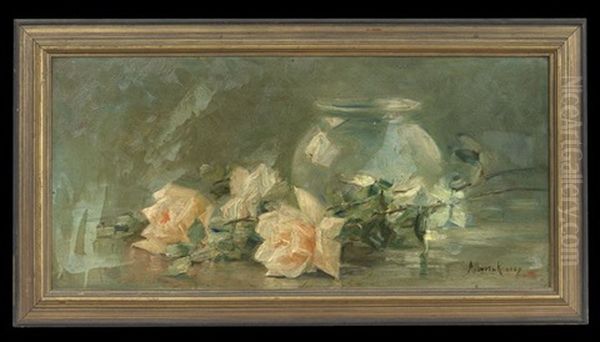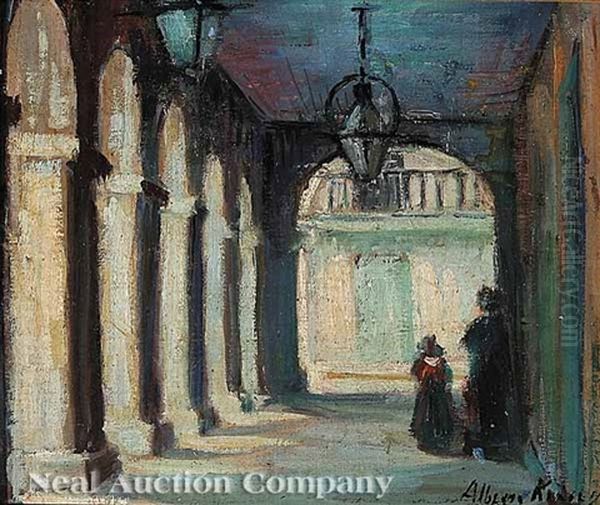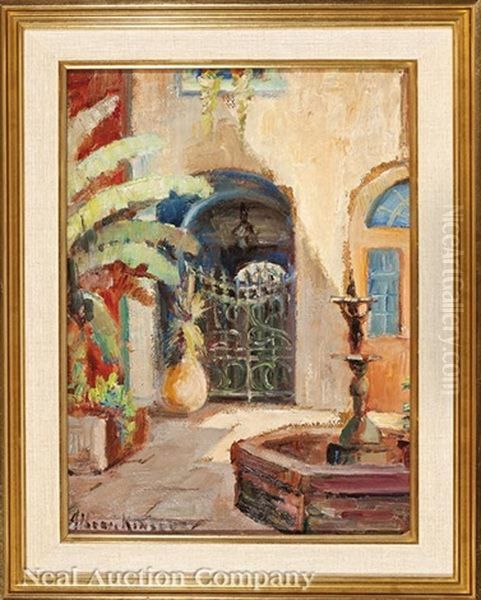Alberta Kinsey stands as a notable figure in the artistic heritage of New Orleans, an artist whose life (1875-1952) spanned a period of significant cultural evolution in the Crescent City. Primarily recognized for her evocative oil paintings, Kinsey dedicated much of her talent to capturing the unique ambiance and architectural beauty of New Orleans, particularly its famed French Quarter courtyards and streetscapes. Her work, characterized by a keen eye for detail and a sensitive use of color, offers valuable visual documentation of the city's charm during the early to mid-twentieth century. Beyond her own canvases, Kinsey played an unexpected but crucial role in the burgeoning career of one of Louisiana's most celebrated folk artists, Clementine Hunter.
Unveiling the Artist: Early Life and Formation
Despite her recognized contributions to the New Orleans art scene, concrete details about Alberta Kinsey's early life, birthplace, and formal artistic training remain elusive. The available records focus more on her active years as a painter and her engagement with the artistic community, rather than her formative experiences. It is known she was actively painting and involved in the New Orleans art world, particularly from the 1910s through the 1940s, although her lifespan suggests a potentially longer period of artistic activity.
What is clear is her deep connection to New Orleans. She was not merely an observer but an active participant in its cultural life. Sources place her within the vibrant, sometimes bohemian, circles of the French Quarter's burgeoning arts community. Her presence suggests an immersion in the city's unique atmosphere, which undoubtedly fueled her artistic practice. The lack of information on formal training doesn't preclude study, perhaps privately or through workshops, but it emphasizes that her reputation rests firmly on the body of work she produced and her interactions within the New Orleans milieu.
The French Quarter Milieu: Community and Preservation

Alberta Kinsey was deeply embedded in the artistic lifeblood of the New Orleans French Quarter during a pivotal era. This historic neighborhood, with its distinctive architecture and vibrant street life, was undergoing a period of rediscovery and preservation, attracting artists, writers, and intellectuals. Kinsey was not just a resident artist capturing its scenes; she was part of the movement that sought to protect and celebrate its unique character.
Her association with prominent local figures like writer and preservationist Lyle Saxon underscores her involvement. Accounts suggest they were part of a close-knit group that frequented studios and salons, discussing art, literature, and the future of the Quarter. One anecdote places Kinsey and Saxon together witnessing the dramatic fire that consumed the iconic French Opera House in 1919, an event that galvanized the local arts community.
This event reportedly spurred Kinsey and Saxon, among others, to formalize their community efforts. They were instrumental in the founding of the "Artists' Guild," establishing its first clubhouse in the historic Jackson House on Royal Street. This organization provided a crucial hub for artists, fostering collaboration and advocating for the preservation of the French Quarter's architectural integrity. Kinsey's participation highlights her role not just as a painter but as a proactive cultural force, a pioneer in the nascent preservation movement that helped save the Vieux Carré we know today. Her contemporaries in this vibrant scene included artists like William Woodward and Ellsworth Woodward, brothers who were influential educators and painters, as well as figures like Knute Heldner and Colette Pope Heldner, known for their depictions of Louisiana life and landscapes.
Artistic Vision: Style and Subject Matter
Alberta Kinsey's artistic output primarily focused on oil painting, though watercolors like Still Life with Roses demonstrate her versatility. Her signature subjects were the intimate courtyards, hidden gardens, and atmospheric street views of New Orleans. These were not mere topographical records; Kinsey imbued her scenes with a palpable sense of place, capturing the interplay of light and shadow, the textures of aging stucco and brick, and the lushness of tropical foliage characteristic of the city's hidden spaces.

Her style can be described as representational, leaning towards realism with a strong emphasis on detail and accurate depiction. Works like View of a Courtyard and An Old Court Yard exemplify this approach. She possessed a refined sensitivity to color, effectively conveying the specific light and mood of the New Orleans environment – the humid warmth, the dappled sunlight filtering through leaves, the vibrant hues of flowers against weathered walls. Her brushwork, while detailed, often retained a painterly quality, avoiding photographic rigidity.
Beyond cityscapes, Kinsey also engaged with still life painting. Works such as Still Life of Flowers in a White Vase and the sketch inspired by flowers at Melrose Plantation showcase her ability to capture the delicate beauty of floral arrangements. In both her architectural scenes and still lifes, there is a consistent thread of careful observation and an appreciation for the visual richness of her surroundings. Her paintings serve as windows into a specific time and place, rendered with skill and affection.
Documenting History: The Hermann-Grima House Courtyard
One of Alberta Kinsey's significant extant works is her oil painting depicting the courtyard of the Hermann-Grima House, a historic landmark in the French Quarter. Created around 1935, this painting is a prime example of her focus on New Orleans' architectural heritage and her skill in rendering these complex, atmospheric spaces. The Hermann-Grima House, built in 1831, is renowned for its meticulously restored Creole architecture and courtyard, offering a glimpse into nineteenth-century urban life.
Kinsey's painting captures the essence of this historic space. One can imagine the careful rendering of the flagstones, the textures of the brick walls, the characteristic galleries, and the arrangement of plantings within the courtyard. Her attention to detail would have extended to the quality of light filtering into the space, defining forms and creating the tranquil yet structured atmosphere typical of these enclosed gardens.
The painting is more than just a depiction; it's a historical document rendered through an artistic lens. By choosing such subjects, Kinsey participated in the broader cultural project of recognizing and valuing the unique architectural legacy of New Orleans. The donation of this specific work to the Louisiana State University Library Special Collections ensures its preservation and accessibility, allowing future generations to appreciate both the historic site and Kinsey's artistic interpretation of it. It stands as testament to her dedication to capturing the enduring beauty of the city's past.
An Unexpected Legacy: Inspiring Clementine Hunter

Perhaps one of the most widely recounted aspects of Alberta Kinsey's life is her serendipitous role in launching the career of the iconic Louisiana folk artist, Clementine Hunter (c. 1887-1988). The story typically takes place in the late 1930s, likely around 1939 or 1940, at Melrose Plantation in Natchitoches Parish. Melrose, under the stewardship of Cammie Garrett Henry, had become a haven for artists and writers, a Southern version of Yaddo or MacDowell.
Alberta Kinsey was among the many artists who visited Melrose. During one such visit, upon departing, Kinsey reportedly left behind a set of used oil paints and brushes. Clementine Hunter, then working at Melrose primarily in domestic roles and as a field hand, discovered these discarded materials. According to Hunter's own accounts and those of others like Francois Mignon, a writer and long-term resident at Melrose who became Hunter's champion, this was the catalyst she needed.
Intrigued and inspired, Hunter famously declared, "I think I can paint," or similar words, and used Kinsey's leftover supplies to create her first paintings, often said to be executed on discarded window shades or cardboard. While some accounts mention a specific first work like Bowl of Zinnias (a title also associated with a Kinsey still life, causing some confusion), the core narrative remains consistent: Kinsey's act, intentional or not, provided the material means for Hunter to begin translating her lifetime of observing plantation life into the vibrant, narrative-rich paintings that would make her famous. This connection firmly places Kinsey at the genesis point of one of America's most important folk art careers.
Contextualizing Kinsey: New Orleans and Beyond
Placing Alberta Kinsey within the broader art historical context involves recognizing her primarily as a regional artist deeply connected to the New Orleans school of painting in the early 20th century. Her work aligns with the tradition of artists who found inspiration in the specific character and atmosphere of their local environment, a current seen across American art of the period, sometimes falling under the umbrella of American Scene Painting or Regionalism, though she may not have formally identified with these movements.
Her focus on the architectural details and intimate spaces of the French Quarter resonates with the work of contemporaries and predecessors who also documented the city, such as the aforementioned Woodward brothers. While stylistically distinct, her dedication to capturing the 'genius loci' can be compared to artists documenting other unique American locales, like Alice Ravenel Huger Smith's watercolors of the Charleston Lowcountry or, from an earlier era, William Aiken Walker's depictions of the post-bellum South.
While direct stylistic influences beyond her immediate New Orleans circle are difficult to pinpoint from the available information, her realistic yet painterly approach to cityscapes shares some distant kinship with urban documentarians like Joseph Pennell, known for his etchings and prints of cities, or even the Impressionist-influenced city views of Childe Hassam, though Kinsey's style appears more grounded and less overtly Impressionistic. Her primary significance, however, remains rooted in her contribution to the visual record and artistic life of New Orleans and her pivotal, if unintentional, mentorship role for Clementine Hunter. Other artists associated with the Melrose Plantation milieu, like Weeks Hall of The Shadows-on-the-Teche, also contribute to this rich tapestry of Southern art patronage and creation.
Enduring Contribution and Artistic Standing
Alberta Kinsey's legacy resides primarily in her sensitive and skillful depictions of New Orleans, particularly its French Quarter. Her paintings offer valuable historical insights into the appearance and atmosphere of the city during a period of transition and burgeoning cultural self-awareness. She was an artist who clearly loved her subject matter, rendering its unique blend of decay and beauty, history and life, with dedication and care.
Her active participation in the French Quarter's artistic community and her role alongside figures like Lyle Saxon in early preservation efforts and the founding of the Artists' Guild mark her as a significant local figure beyond her individual artistic output. She contributed to the infrastructure and spirit that allowed the arts to flourish in the Vieux Carré.
While she may not have achieved the national fame of some American artists of her generation, her work is held in collections and appreciated by those interested in the art history of Louisiana and the American South. Furthermore, her connection to Clementine Hunter adds a unique dimension to her story, highlighting the often-unpredictable ways artistic influence can be transmitted. Alberta Kinsey remains an important figure for her chronicling of New Orleans' soul and her part in the interwoven narrative of Southern art in the twentieth century. Her paintings continue to evoke the timeless charm of the Crescent City.